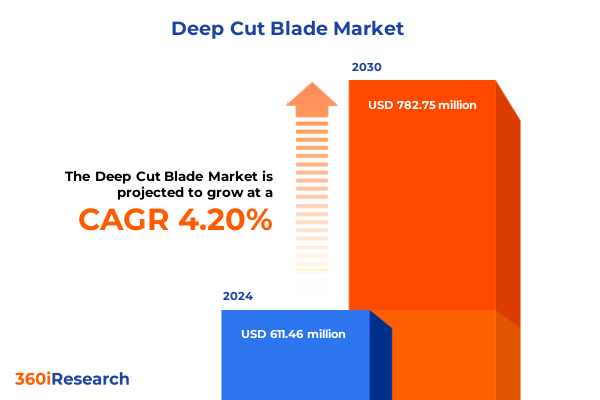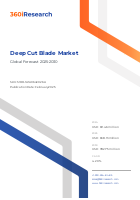The Deep Cut Blade Market size was estimated at USD 611.46 million in 2024 and expected to reach USD 638.13 million in 2025, at a CAGR 4.20% to reach USD 782.75 million by 2030.

Introduction to the Evolving Deep Cut Blade Ecosystem
The deep cut blade market is experiencing rapid evolution driven by technological innovation, shifting user demands and global economic pressures. This report provides a comprehensive overview of the factors reshaping the industry, from material science breakthroughs to emerging end-user requirements. By examining the current state of blade design and manufacturing, as well as the forces influencing strategic decision-making, this introduction lays the foundation for a deeper understanding of competitive dynamics. We explore how precision engineering, automation and digital integration are elevating performance standards, while regulatory and sustainability concerns are redefining design imperatives. Stakeholders across supply chains-from raw-material suppliers to professional contractors-must navigate a landscape characterized by heightened complexity and opportunity. Through a blend of qualitative analysis and expert perspectives, this section sets the stage for the transformative shifts, tariff impacts and segmentation insights detailed in subsequent chapters. It equips decision-makers with the context needed to assess market position, identify growth vectors and anticipate future challenges. In doing so, it frames the strategic importance of investing in innovation, strengthening partnerships and enhancing operational resilience as foundational pillars for success in the evolving deep cut blade sector.
Transformative Shifts Redefining the Deep Cut Blade Industry
The deep cut blade industry is undergoing transformative shifts as connectivity, materials science and sustainability converge. Manufacturers are integrating sensors and IoT capabilities into smart blades, enabling real-time wear monitoring and predictive maintenance that reduce downtime. At the same time, demand for eco-friendly tooling has accelerated research into biodegradable coatings and low-emission manufacturing processes. Digital manufacturing technologies, including additive fabrication and CNC optimization algorithms, are streamlining production cycles and shrinking lead times. Trade dynamics are also reshaping the landscape: companies are diversifying supply chains to mitigate geopolitical uncertainty, adopting nearshoring strategies and forging collaborative partnerships to secure critical raw materials. Customer expectations have grown more nuanced, with segments such as aerospace and automotive requiring ultra-tight tolerances, while DIY enthusiasts and specialty workshops seek accessible platforms for customization. As a result, agility and innovation have become non-negotiable prerequisites for market leadership. These converging trends are driving vertical integration, strategic acquisitions and enhanced R&D investment, positioning forward-thinking players to capitalize on efficiency gains and unlock new revenue streams.
Cumulative Impact of 2025 U.S. Tariffs on Input Costs and Supply Chains
The introduction of new tariff schedules in 2025 has had a cumulative impact on the deep cut blade market, particularly affecting steel and carbide input costs. Increased duties on high carbon steel imports have prompted manufacturers to pursue alternative supply sources, leading to regional reshoring initiatives and longer-term contracts with domestic mills. Simultaneously, tariffs on premium grade carbide have elevated raw material expenses, squeezing margins and accelerating the adoption of recycled carbide scrap in manufacturing processes. Price volatility has compelled OEMs to implement dynamic pricing strategies, passing select costs to end users while absorbing others to maintain competitive positioning. Supply chain partners have responded by diversifying logistics networks and building buffer inventories, albeit at the expense of higher carrying costs. Moreover, the tariff regime has spurred innovation in material science, as companies intensify R&D to develop proprietary alloys and hybrid composites that circumvent duty classifications. In aggregate, these measures have yielded a market that is more resilient yet cost-conscious, encouraging collaboration between blade producers, material suppliers and end-user segments to balance quality expectations with economic realities.
Key Market Segmentation Insights Driving Specialized Strategies
A multifaceted segmentation framework reveals tailored opportunities across the deep cut blade ecosystem. By product type, the market encompasses single-depth blades subdivided into general purpose and specialty application variants, alongside variable depth blades differentiated by manual adjustment and advanced smart blade technologies. Application segments reveal that commercial users-primarily construction industries and landscaping services-demand high-throughput solutions, whereas home use customer groups engaged in craft and hobby or furniture making prioritize precision and ease of handling. Industrial end-uses span aerospace engineering and automotive manufacturing, where exacting tolerances and material compatibility are paramount. Material type segmentation distinguishes between premium grade and standard carbide blades, as well as high carbon and stainless steel offerings, each delivering unique performance characteristics. End-user analysis identifies hobbyists and self-taught artisans among DIY enthusiasts, educational institutions and training centers under institutional use, and professional contractors such as builders, developers and handymen. Blade edge preferences contrast serrated options with major or minor serration against straight configurations featuring micro-beveled or smooth edges. Sales channel insights separate offline retail channels-big box retailers and specialty tool shops-from digital avenues including brand websites and e-commerce platforms. Finally, durability considerations range from regular everyday use blades to wear-resistant variants offered in coated and non-coated forms, guiding lifecycle management and aftermarket support strategies.
This comprehensive research report categorizes the Deep Cut Blade market into clearly defined segments, providing a detailed analysis of emerging trends and precise revenue forecasts to support strategic decision-making.
- Product Type
- Application
- Material Type
- End-User
- Blade Edge
- Sales Channel
- Durability
Regional Insights Highlighting Distinct Market Drivers
Regional dynamics shape both demand patterns and competitive intensity within the deep cut blade market. In the Americas, robust infrastructure investments and a thriving home improvement sector underpin sustained growth, while domestic steel production dampens raw material volatility. Regulatory frameworks emphasize workplace safety and environmental compliance, driving adoption of premium alloys and low-emission coatings. In Europe, Middle East & Africa, stringent quality standards in aerospace and automotive hubs foster a preference for high-precision tools; trade alliances and harmonized certification processes facilitate cross-border collaboration, yet energy costs and import duties can challenge margin structures. The Asia-Pacific region stands out for rapid industrialization and expanding construction projects, spawning heightened demand for both cost-effective and high-performance blades. Local manufacturing clusters in Japan, South Korea and China excel in carbide technology, intensifying competition and accelerating innovation cycles. In each region, strategic priorities revolve around aligning product portfolios with regulatory landscapes, optimizing distribution networks and tailoring aftersales support to diverse end-user expectations.
This comprehensive research report examines key regions that drive the evolution of the Deep Cut Blade market, offering deep insights into regional trends, growth factors, and industry developments that are influencing market performance.
- Americas
- Asia-Pacific
- Europe, Middle East & Africa
Competitive Landscape and Leading Company Strategies
The competitive landscape is marked by both established conglomerates and specialized innovators vying for market share. Legacy manufacturers such as Amada Corporation and Sandvik AB leverage extensive R&D pipelines and integrated manufacturing capabilities to deliver premium solutions. Specialist component producers including Autocam Precision Components Group and Precision Resource, Inc. excel in custom tooling applications. Industry stalwarts like Federal-Mogul Corporation and Kennametal Inc. have fortified their positions through strategic acquisitions, acquiring niche players such as Widia Products Group and The M. K. Morse Company to expand product breadth. Innovators including Makita Corporation and Makita-peers in power tool integration focus on embedding smart blade technologies into cordless platforms. Companies such as Bahco (SNA Europe) and Walter AG prioritize ergonomic design and sustainability, while Sumitomo Electric Carbide, Inc. and Mitsubishi Materials Corporation push the boundaries of carbide composites. Niche players like International Knife and Saw Inc. and Daniels Manufacturing Corporation capitalize on legacy craftsmanship in industrial sawing. EBC Brakes, DoALL Sawing Products and Freeman Schwabe Machinery round out the ecosystem with complementary offerings. Each player’s strategic focus-whether driven by technology leadership, distribution reach or customer intimacy-achieves differentiation in a market defined by precision and performance.
This comprehensive research report delivers an in-depth overview of the principal market players in the Deep Cut Blade market, evaluating their market share, strategic initiatives, and competitive positioning to illuminate the factors shaping the competitive landscape.
- Amada Corporation
- Autocam Precision Components Group
- Bahco (SNA Europe)
- Daniels Manufacturing Corporation
- DoALL Sawing Products
- EBC Brakes
- Federal-Mogul Corporation
- Freeman Schwabe Machinery
- International Knife and Saw Inc.
- Kennametal Inc.
- LENOX Industrial Products & Services
- Makita Corporation
- Mitsubishi Materials Corporation
- Precision Resource, Inc.
- Sandvik AB
- Stanley Black & Decker, Inc.
- Sumitomo Electric Carbide, Inc.
- The M. K. Morse Company
- Walter AG
- Widia Products Group
Actionable Recommendations for Deep Cut Blade Market Leaders
Industry leaders should prioritize a three-pronged approach to secure long-term growth. First, accelerating the integration of smart blade functionality-incorporating IoT sensors and predictive analytics-will enhance value propositions for both commercial and industrial users. Second, diversifying raw material sourcing through strategic partnerships and recycled material initiatives will mitigate tariff-driven cost pressures and align with sustainability commitments. Third, strengthening omnichannel distribution-blending specialty retail, big box presence and direct-to-customer e-commerce-will optimize market coverage and customer engagement. In addition, investing in modular blade designs and aftermarket service platforms will create recurring revenue streams and fortify customer loyalty across segments. Collaborative R&D alliances with academic and industry consortia can expedite the development of next-generation alloys and eco-friendly coatings. Finally, embedding agility into organizational processes through lean manufacturing practices and digital supply chain management will ensure responsiveness to evolving demand signals and geopolitical dynamics.
Explore AI-driven insights for the Deep Cut Blade market with ResearchAI on our online platform, providing deeper, data-backed market analysis.
Ask ResearchAI anything
World's First Innovative Al for Market Research
Conclusion and Path Forward for Market Participants
The deep cut blade market stands at the intersection of innovation, regulation and shifting end-user requirements. As technological capabilities expand and tariff regimes evolve, companies that align their product strategies with segmentation insights and regional demand drivers will achieve competitive advantage. Success hinges on balancing cost efficiency with performance differentiation, leveraging smart tooling advancements, and fostering resilient supply chain partnerships. By adopting the actionable recommendations outlined herein-spanning digital integration, material diversification and omnichannel optimization-organizations can navigate market complexities and unlock sustainable growth. Continuous learning, strategic collaboration and disciplined execution will be the hallmarks of industry leaders who chart the path forward in this dynamic landscape.
This section provides a structured overview of the report, outlining key chapters and topics covered for easy reference in our Deep Cut Blade market comprehensive research report.
- Preface
- Research Methodology
- Executive Summary
- Market Overview
- Market Dynamics
- Market Insights
- Cumulative Impact of United States Tariffs 2025
- Deep Cut Blade Market, by Product Type
- Deep Cut Blade Market, by Application
- Deep Cut Blade Market, by Material Type
- Deep Cut Blade Market, by End-User
- Deep Cut Blade Market, by Blade Edge
- Deep Cut Blade Market, by Sales Channel
- Deep Cut Blade Market, by Durability
- Americas Deep Cut Blade Market
- Asia-Pacific Deep Cut Blade Market
- Europe, Middle East & Africa Deep Cut Blade Market
- Competitive Landscape
- ResearchAI
- ResearchStatistics
- ResearchContacts
- ResearchArticles
- Appendix
- List of Figures [Total: 30]
- List of Tables [Total: 1024 ]
Call to Action: Connect with Ketan Rohom for Comprehensive Market Insights
For further insights and to secure the full in-depth market research report, contact Ketan Rohom, Associate Director, Sales & Marketing.

- How big is the Deep Cut Blade Market?
- What is the Deep Cut Blade Market growth?
- When do I get the report?
- In what format does this report get delivered to me?
- How long has 360iResearch been around?
- What if I have a question about your reports?
- Can I share this report with my team?
- Can I use your research in my presentation?




